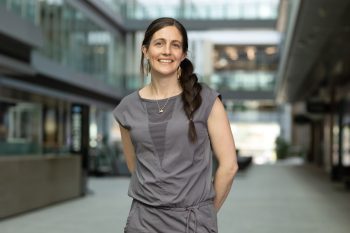A team led by Professor Warren Chan (IBBME, Donnelly Centre) is developing an automated, more sensitive and rapid test for COVID-19 to help curb the pandemic.
The current global lockdown only made their resolve to continue with their research stronger.
“It is very rewarding being able to work with everyone and do something that is contributing to this and future epidemics,” says Hannah Kozlowski (IBBME MD/PhD candidate).
Widespread testing is needed to detect and quickly isolate infected people with mild or no symptoms to halt the virus’ rapid spread
The project is funded through the Toronto COVID-19 Action Fund launched last month by U of T in support of high-impact research aimed at halting the spread of the novel coronavirus.
Powered by tiny light-emitting nanocrystals known as quantum dots, the test can simultaneously detect multiple components of the SARS-CoV-2 genetic material, making it more sensitive than most available methods which measure only one viral gene at a time. Single tests have a level of uncertainty and can sometimes give false negative results in people who are infected.
“A lot of available tests out there are faulty but people are using whatever is available and works best at this point,” says Chan, Director of IBBME and principal investigator at the Donnelly Centre for Cellular and Biomolecular Research. “Some of the tests were developed without even being tested on patient samples,” he added, meaning that the tests have not been optimized for detecting variable amounts of the virus across patients.

Chan has the benefit of collaborating with infectious diseases specialists Drs. Samira Mubareka, of Sunnybrook Hospital, and Jonathan Gubbay, of Public Health Ontario, who are providing patient swab samples from the frontline so that the test can be calibrated for clinical use. They joined forces in 2016 to develop a test for the Zika virus, but switched their focus to COVID-19 as it began spreading out of China.
They are also working with Gary Bader, a professor of molecular genetics and computer science in the Donnelly Centre, who is tracking how the virus is evolving so that the test can be adjusted to capture new strains as they appear.
The test is based on quantum dots, nano-scale particles that glow in bright colours when struck by light. These particles can be fitted into umpteen microscopic machineries, each looking for signs of the virus while emitting a unique spectrum of light that can be harnessed for test readout. Such collective chemistry produces more data points and serves to increase confidence in test results.
The test is also rapid, revealing results in under an hour, and it can be carried out outside hospitals or specialized labs. On-the-go testing like this employs a relatively recently developed chemistry in which DNA is amplified at constant temperature unlike the standard method that requires frequent temperature changes obtainable only with specialized instruments.
Matthew Osborne (IBBME PhD candidate) is tasked with fitting the entire process — from receiving a swab sample to detecting viral material inside it — into a portable device with a smartphone readout.
“The general idea is that you have a reusable platform that you plug disposable cartridges into, where each cartridge processes a single patient sample,” says Osborne.
“We want the user who’s using the device to have to do the least amount of work possible,” he says.
The newest member of the lab, Hongmin Chen (IBBME PhD candidate), who joined the team in January, is taking care of software development.
The device prototype stems from a career marked by deadly outbreaks. In 2003, SARS was wreaking havoc in Toronto soon after Chan joined U of T as a young faculty member. He set out developing diagnostics based on quantum dots, whose application in life sciences researchers were just beginning to explore.
While the device is currently being optimized for the detection of SARS-CoV-2 genetic material, the tool can be adapted to spot antibodies generated in response to the infection to find out who is immune.
“We have been putting this in place for 18 years,” says Chan. “We took the time to develop all the science behind it and now we have a plug-and-play system that can be applied for various applications,” he says.
The team together made the decision to continue working on their COVID-19 project during lockdown, for which it had to obtain special permission from the University.
“It’s a project that we’ve already been working on and the pandemic has really pushed us to improve and hopefully make an impact sooner,” says Osborne.



